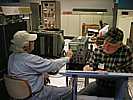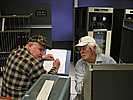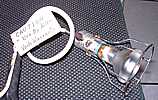- Wednesday January 5th - 10 AM -
Present were: Bob Erickson, Ron Williams, Frank King, Ed Thelen, Milt Thomas, Dan McInnis, Robert Garner. Big hardware push was to get the 1403 (printer) powered up. After many attempts involving chattering relays, flickering voltages in 1401, tripped circuit breaker of bottom phase of the Elgar 50 Hz converter, we decided to try starting the motors in the 1402 reader/punch. The V-belts were removed from the reader motor and the punch motor and we tried to start the 1402 motors. No response - something disconnected in the 1402. Frank King is planning to bring heavy wire Saturday to connect just the 1403 to the Elgar. See if the Elgar can start the freestanding 1403. Ed Thelen and Dan McInnis looked through the card boxes verifying and trying to add detail to the 1401-punched-card-inventory-Aug2004 - not much detail added. Allen Palmer removed the reel drive belts from the "green" 729 tape unit in preperation for de-rusting the V-belt grooves and inserting new drive belts. Bill Selmeier negotiated with Chris Garcia for delivery of a hopefully working 026 card punch to back up the coming Saturday card reading to CD-ROM session.- Saturday January 8th - 9:30 AM - second Saturday - free food ;-)) and work also
Report by Bill Selmeier - A collage of many people assisted me today in getting about 5 of the 20 or so boxes read into about 54 disk files each of which passed a verification run. We created a file for each unique card set, even if it was only 7 cards in the set. Most of the programs appeared to be utilities such as card to tape, 80-80 list, etc. Data was captured in binary format using Brian Knittle's awsome card reader program that car write and verify cards at about 600 cpm. Meta data collected included the box that the card deck came from, anything that was handwritten on the decks and the number of cards in each set. Many thanks to the right hand men: Ed Thelen and Alex Bochannek for operating the Card Reader. Dave Babcock and Dan McInnis stopped and provided direction.
On Friday Chris Garcia put what we thought was a working IBM 029 in the room we're using, after an earlier selected machine that had worked at Moffett turned out to no longer work. Unfortunately the second machine also turned out not to work, but we got help. Tim Coslet, Ron Williams, and Bob Erickson spent the day being field engineers repairing the key punch. Bob found a logic card that was completely split in two. A victim of the move from Moffett? Long story - short, they got it to feed cards, but not dupe cards. We did dupe the one card we encountered with a skewed manual punch in it by using a manual key punch. Great progress. More will be accomplished over the next few weeks.- Wednesday January 12th - 10 AM - Roll up sleeves - Report by Robert Garner -
Good progress today: Frank powered up his 1403 motors for 1st time, Ron & Bob "shot some bugs" in the 1401 timing logic (found a bad SMS card!), Bill swapped the punch unit between the 1402's, Allen worked on his mechanicals (more stuff for my IBM Almaden machinist "Bob"). and I cleaned the floor!Based on my measurement today, Frank turned on 924 VA of motors--no problem w/ Elgar. (Just the 1401 fans were on, which draws 550 VA on Phase B, leaving a 850 VA margin on phase B, or 850*3=2.5 kVA of 3-phase motor startup power available. Which implies the motor startup surge that might trip the Elgar shutdown circuits was less than 2.7x static current.) Adding in the two motor nameplates Frank didn't turn on today (ribbon, chain), his total motor power will be about 1.2 kVA. An 18 kVA supply, with the 5 tape drives off, will allow for a 1403 surge of 18 kVA - 4 kVA (system static pwr) = 14 kVA / 1.2 kVA = 11x, which is better than the worst-case ratio I've seen (7 - 10x). The 729 tape drive power-on motors (2 belt, vacuum motor) are just 550W, half of 1403 and no problem either.
- IBM 1401 Restoration Project Report, January 16, 2005 by Robert Garner.
- Just a note Brian Utley, the 1130's Project Manager from 1963 through its launch, visited the 1401 Sun Jan. 2005 - He said he never liked the way the ALS documents were formatted - not enough information - a functional icon, like AND and OR gates would have been more useful to the working engineer or service person.
- Wednesday January 19th - 10 AM - Chuck, Ed, Frank, Bob, Don, Ron and Allen showed up. It quickly became evident that the Elgar frequency converter was now too weak to continue - the bottom of three units of the Elgar trips after about a minute with only the 1401 on line. Plugging in the oscilloscope while the 1401 is ON trips the Elgar immediately :-((. Frank powered up the 1403, but with out the 1401 and 60 volt power interlocks, nothing could be accomplished. There is increasing concern that collapsing power, rather than the organized Power Off sequence might cause increasing damage. Chris Garcis of the museum supervised the return of the Visible Storage 1402 to its normal place. The 026 keypunch in the 1401 room is inoperative - among other things, a 25L6 tube had a crack glass envelope - Ed went to the local "boy's toy stores" to find a replacement. None - Internet time! Most of the volunteers went home at noon. Bob Erickson instructed Ron Williams and Ed Thelen in the intracies of the 026 key punch until about 4:00 - non-trivial - Al Kossow has a manual at http://www.bitsavers.org/pdf/ibm/cardProc/A24-0520-2_24-26_keypunches.pdf
- Saturday January 22th - 9:30 AM - 4th Saturday - Roll up sleeves -
We had quite a crew doing lots! Ron Williams, Bob Erickson, Tim Coslet and Ed Thelen exchanged the positions of two amplifiers in the Elgar 50 hertz generator, it worked, but I don't think we want to do it again - large masses of iron (transformers) are startlingly heavy. The 1401 now starts and runs, and comtinues running (1402 and 1403 still unpowered.Ron Williams, Bob Erickson, Robert Garner and Tim trouble shot some bad lamp drivers and/or circuitry. The 8 light in the high order address display was stuck ON. They needed ALD 42.xx.xx so found the museum copy, and copied it and other documents into working master and working copies.
Ron Mak showed Van Snyder (author of 1401 Autocoder program runable on a PC) and Ed Thelen Ron's JAVA encapsulation of
- 1401 Autocoder by Van Snyder
- 1401 SIMH simulation program by
in a wonderfully user friendly development environment complete with assembly text highlighting and break points, single stepping, and memory displays. Ron is now working on a console interface but the current version is so superior to the command line interfaces that I want his alpha release *RIGHT NOW*.Ron Williams, Bob Erickson, and Tim Coslet continued debugging the 1401.
Later Tim Coslet and Ed Thelen worked on the 026 key punch. We found that reforming the 200v 200 ufd capacitor with a 4 watt lamp eliminated the blowing of fuses and the machine now passes cards to some extent. The rubber rollers on each side of the read station are hardened and slicked and need to be resurfaced or some chemical restorative is needed.
- Wednesday January 26th - 10 AM - Roll up sleeves -
Good News first - The Elgar 50 Hz machine hanging in there, enough power for the processor. Bob provided Tim with a 026 timing chard. Tim fixed the new keypunch enough to get some holes punched - some decode troubles. Allen and Glenn replaced belts on several tape units. They are now looking for cylindrical brushes for the tape clutches. Frank and Ed copied some more schematics for Ron and Bob to use.
Robert Garner studied installation problems for a proposed replacement for the Elegar 50 Hz power unit and installed 22 floor tiles (donated by IBM San Jose) to replace the older ones with feet-catching cutouts. He also rearranged the holey tiles for improved air circulation and cooling."
Ron and Bob continued bug shooting the 1401 processor until ...
Bad News: - the YGL regulator card of a 6 volt power supply failed. There are none in the spares. Dr. Mike Williams let us look at the (newer) 1401 in Visible Storage - but the new series apparently used different cards. Tim took the defective card home to test components using his in-circuit tester.- Sunday Sunday January 30 - 10 AM - Special Session -
All Good News - Tim Coslet, Ed Thelen & Randy Thelen arrived to try to fix the defective YGL card so that the 1401 could be fired up and testing continue this coming Wednesday. Tim brought his in-circuit tester and his oscilloscope. After some comparisons with a good YGL card (from the other required 6 volt power supply) with the in-circuit tester, Tim determined that T-5 transistor was likely sick as tested in the open-base configuration. Randy (steady hands) Thelen removed the suspect transistor and Tim tested it in a standalone fixture.
T-5 transistor was indeed a bad transistor :-)) Using SMS board schematics Tim determined that T-5 was an IBM part 026 transistor, part of an input differential pair. Using Bob Ericksons TRANSISTOR REPLACEMENT chart, we determined the T-5 (026) could be replaced by a commercially available 2N270. :-))
We disbursed for other things. Randy Thelen took the board to Radio Shack and Fry's to find a suitable transistor - no luck. At a second Fry's, Randy found that an NTE-102 was listed as a substitute for the 2N270 - and that Fry's had exactly one. :-)) Randy bought and at his home soldered the NTE-102 into the T-5 position.
At 6:00 PM we re-convened at CHM. Tim tested the board with his in-circuit tester - and it looked good! :-))
That 6 volt 10 amp power supply now regulates very well! 6.049 volts no load, 5.966 at 11 amps for a droop of only 1.4% -excellent:-)) (We were using the test load from the PDP-1 group - Thanks much.)
Testing of the 1401 can resume Wednesday !!Tim got the 026 keypunch to duplicate :-)) , There still seems to be a decoding problem in the keyboard preventing a 2 row punch in alpha mode.
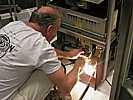
Allen 729 Terms
729 Mechanicals
077 Naked
3-48 shoulder Screw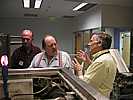
Glenn Ed JToole- Wednesday February 2nd - 10 AM - Roll up sleeves -
Attending - Allen, Bob, Ed, Robert, Bill Flora, Glen, Ron :-))
Allen, Glen and Ron got power to one 729 tape drive with out powering most of the 1401 (and tripping the Elgar circuit breakers). Allen had spent months lovingly cleaning, checking, replacing belts, ... Allen says that he had dreamed that the 729 would come right up - but the dream died - poof - . We need tape! We scrambled about looking for a scratch tape and a take up reel - OK - so people give good stuff to museums - not dull stuff like scratch tapes and take-up reels! In any case, bug shooting the 729 has started. Many hands assisted in the activities.
Bill Flora took a LONG lunch hour off of work and worked on the 1402 reader punch. The belts had been removed from the motors months ago to prevent possibly driving the system backword if a phase reversal on the 3 phase input. (During early bring up we had bypassed the phase sequencing check for several reasons.) So while the 1401 was not drawing power, he started the card reader and card punch motors - both backward. Hmmm are the 729 tape drive motors running backward also? Folks had forgotten the correct technique in re-installing the punch die mechanism (say after clearing a jam). Bill discovered that a person must *not* push up on the central handle - push up on the sides - the central handle is involved with engaging the locking mechanism.
Since no work was going on at the 1401 processor, Bob Erickson worked on the 60 hz 029 keypunch - checking and re-adjusting the timing contacts associated with feeding and positioning cards. After an hour or two, the keypunch works even better - even the mysterious missing 2 punch in alphas now works correctly - we can punch cards. But, the keyboard needs a real cleankng, the star wheels and format drum needs checking - and Bob *REALLY* does not want to fight a printer problem.- Extra Saturday February 5th - 10 AM - There *was* free pizza!!!
Ron Williams, Tim Coslett and Ed Thelen showed up. What to do? Well lets get the motors in the 1402 going going in the correct direction :-)) Reversing 2 phases of the three phase current should do that. And assuming that the low vacuum in the tape drives is due to reversed vacuum centrificul fan rotation, that might get fixed also. So "we" chose to reverse the wires in the Hubble Plug coming out of the 50 Hz Elgar, and "we" (Ron) reversed phases phases marked 2 and 3. Powered up the 1401 - and the breaker of the middle 50 Hz Elgar amplifier tripped. :-(( Bummer!! Switched the big load to the weak amplifier or circuit breaker. So "we" (Ron) un-reversed wires marked 2 and 3, then reversed wires marked 1 and 3. *NOW* the 1401 runs AND the motors in the 1402 run in the direction indicated by the arrow :-))
Fine, Tim was working on "our" keypunch - and it began to work correctly :-))
So the three of us began to bug shoot why the registers shown on the front panel of 1401 do not get set correctly from the front panel switches. (This effort has been continuing for several weeks - and did not get solved this day either :-((
We had lots of visitors, including a delegation from Linux Chix - a pleasant surprise. :-))
As we left, I gave a demo of Ron Mak's ROPE a great 1401 development environment, but folks complained that it was too easy and handy!! Not a big problem like "The Good Old Days".
Bob 077 Timing Wheel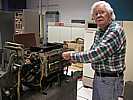
Bob 077
Bill Glenn 729 Feeding Tape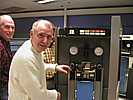
Allen Glenn 729 How To
Allen Glenn 729-1401 Cables- Wednesday February 9th - 10 AM - Roll up sleeves -
Attending - Allen, Bob, Ed, Robert, Frank, Milt, Ron :-))
Good News - All "needed" functions of "our" card punch have been checked and seem to work. Now we need to find a way to ink the print head ribbon to check the printing function.
Not so good news - The Elgar 50 Hz source is so marginal at running the 1401 CPU that turning on an oscilloscope connected to 1401 utility power causes a major momentary dip in the output of the Elgar bottom amplifier.
We punched holes to add Xeroxed documents to binders, examined 729 prints, examined 1403 prints, and occasionally found output of the inputs to the 1401 power supplies to be about 100 volts, instead of nominal ferroresonant regulator output of 131 volts, causing even more strange problems in the 1401.- No meeting this second Saturday February 12th
But Ron Williams, Bob Erickson and Tim Coslet showed up anyway :-))
Report from Bob - All morning Ron copied card diagrams. Kris and I worked on the key punch timed the P Cams and cleaned all the cams and the contacts. had one bug --the 3/4 wasnot punching on special characters. missing wire contacts on R-53-3. Swiped some from a relay that werent being used.... Now everything seems to work O K .. I oiled it and put the covers on it.. You can test it next Wednesday.. Had lunch and then went back to the lab and started the 1401 up. Tim had brought his scope in so we could do some debuging.. Call Ron to get the details on this.!! Thats about it... Bob E- IBM 1401 Restoration Project Report, Febuary 14, 2005 by Robert Garner.
- Wednesday February 16th - 10 AM - Roll up sleeves -
Allen Palmer, Bob Erickson, Robert Garner, Ron Williams, Ed Thelen attended. Allen requested the 50 Hz power, so Allen and Ron trouble shot 729 logic trying to find why the machine insisted on being in "LOAD" mode. Found a marginal lamp operating a sense photocell and a marginal switch. Ed learned that the 729 counts modules right to left rather than left to right as in 1401 placement. And the logic has two pairs of logic levels, similar to the 1401.
Bob and Ed started restoring the 077 collator :-)) We are restoring the 220 volt 50 Hz machine to run on 120 volts 60 Hz. The machine had a post manufacture, post IBM maintenance, 120 volt 48 volt DC power supply (replacing a motor-generator?). The insulation of much "informal" post manufacture wires was badly decomposed (cracked and broke off if moved). We have performed about 1/2 of the needed replacement. The electronic DC power supply worked well after a few seconds of capacitor reforming in series with a small electric lamp. We removed a 230 v to 120 v transformer. The motor adjustable v-belt pulley was so worn as to have sharp edges. Bob is replacing the v-belt pulley and will attempt to adjust it to an 20% smaller diameter for adapting to the 20 % faster RPM 60 Hz power.
Brian Knittle (proud co-owner of an IBM 1130 :-) came by to check the card reader being used for converting 1401 card decks to CD-ROM. He and Bill Selmeier decided that the reader was working OK, no phantom 81st column. Bill Selmeier will resume reading card decks to CD-ROM using Brian's awesome program.- Wednesday February 23rd - 10 AM - Roll up sleeves -
Present were Don Cull, Frank King, Allen Palmer, Milt Thomas, Ron Williams, Bill Flora, & Grant Saviers. The 1402 received full attention :-)) Allen and Grant discussed making replacement parts for the 729 tape drives, and "sand blasting" (with walnut shells) user visible corroded parts on the front of the 729s. Ron and company started working on replacing the de-composing wheels on the 077 collator. Who knows, it may yet roll again :-))- Saturday February 26th - 10 AM - 2nd Saturday - Roll up sleeves -
Present were Tim Coslet, Ed Thelen, Allen Palmer & Ron Williams. Ron found bad board in the 1401 - then power in the 1401 got flaky (the Elgar was OK). The +6 volt, 16 amp power supply would start to output 2 volts, bringing down dependent power supplies. The heat sink of the driver transistor to the main pass transistors was much hotter than normal when this happened. This is the same power supply that had all the other power supply failures
- sick #10 pass transistor, (September 2004) replaced.
- failed transistor to drive the driver transistor, (January 2005) replaced
- now this failure that might be an intermittent short emitter to base in a pass transistor.
We lost about 2 hours trying to identify the intermittent. Monday I will ask to borrow a similar power supply from the Visible Storage machine so progress can continue with the 1401 bring-up. Allen looked on the Internet for miniature tape level lamps for his 729s. One source wants $11 each. On 077 collator, replaced European power plug with American style. (unit already adapted to 110 volts), tried to replace wiring near user POWER ON switch.
Did the museum win the bidding for the new 50 Hz power supply??- Wednesday March 2nd - 10 AM - Roll up sleeves -
Present were Ron Williams, Chuck Kantmann, Bill Flora, Frank King, Bob Erickson, Allen Palmer, Milt Thomas, Ed Thelen. With Dag's permission, we swaped the +6 volt, 16 amp power supply mentioned Saturday February 26th with Visible Storage. The swapped power supply works fine :-)) Allen and Ron worked on a 729 tape drive - after hours of thinking and poking, Allen whoopped and shrieked. We of course assumed the best, that he had gotten shocked ;-) but it turned out that he gotten the rewind logic to work. Now he wants the little reflecting adhesive strips to mark beginning and end of tape allowable data area. Many of the rest of us worked on documentation. Ed made 2 copies of 1402 ECOs, Maintenance Manual, Parts manual. Bill Flora and Milt were working with the 1402 reader punch when we suddenly heard and saw the card reader section activate. Bill was holding the clutch stop in the disabled position and the machine was making that grand old card reading noise. Bill Selmier came by with his camcorder and caught the celebration. Bill S. is sending a copy to some ex-IBMers in Ohio who don't have fun times like this. Sellam Ismail (CHM Software Curator) came by and listened excitedly to Bob Erickson talk about the ERA Able and ERA Atlas, the IBM 603 (its first electronic multiplying unit, shortly followed by the IBM 604 that could even divide electronically! Bob showed his code card from the ERA Atlas. )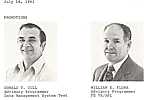
Don Cull & Bill Flora, then and now :-))
(I guess the promotions weren't permanent,
- Fame is so fleeting :-(
Its 2005 and they are both back fixing the 1402 card reader/punch :-((
;-))- Wednesday March 9th - 10 AM - Roll up sleeves -
Present were Ron Williams, Chuck Kantmann, Frank King, Bob Erickson, Allen Palmer, Ed Thelen, Don Cull, Glenn Lea, Robert Garner. Allen and Glenn did some soldering and adjusting and got the 1st 729 Mod V to (mostly) load tape. :-)) Actually, the left hand column doesn't pull all the way to the first position sensor until you hid "Reset" - but who is fussy;-)) Allen says he will have the unit writing tape in two weeks - note that he didn't mention reading ;-))
Allen is looking for some tape markers (the little reflective strips you stick onto tape about 8 feet from either end to indicate beginning of data area and end of data area.
Don Cull and several others checked out the neon timing light driver circuits (like Don and Ed went to Halted to test the 6AL5 dual diode and 12AX7 dual triode). After some time, the timing light circuit is usable if you bypass one selector switch. After some hand speed timing, Don got the 1402 card reader to read its first card in years, and promptly had it's first jam ;-))
Even though the 1401 is all transistor, the 1402 alignment system uses two tubes.
The above activity draws too much power to allow 1401 CPU testing, so Bob Erickson and others worked on the 077 collator - 0.005 here, 0.002 there, the eject clutch had gotten shoved (maybe during some move?) and had to be remounted and realigned.
During lunch Robert Garner played tunes from the IBM Song Book Album from his iPod (digitized from a reel-to-reel tape from Dave Bennet's collection... ;-) The songs were sung by a ladies choir - which I thought was some kind of mis-match. I had imagined that the songs were sung primarily by the IBM sales force, but the ex-IBM CEs assured us that they got into the singing also. Bob Erickson (ex-IBM CE) expressed the idea that more songs were written in adulation of T.J.Watson than for Jesus. :-|
After Allen and Don left, power to the 1401 could be restored and Ron Williams continued to try to activate low storage (memory). We showed Mike Falarski the noisy #2 Liebert after he told us not to use the #1 Liebert because of a bad bearing in its water chiller on the roof. Robert brought in a Tektronix 100-MHz bandwidth scope that he had purchased on e-bay, and put together the Tektronix scope cart he had also purchased.
Mike Falarski told us that IBM is *still* mulling over who won the larger 50 Hz power supply "we" bid on. (The bids were presumably opened Feb. 22) He hopes to know by early next week.- Saturday March 12th - 10 AM - 2nd Saturday - Roll up sleeves -
Present were Ron Williams, Bob Erickson, Tim Coslet, Ed Thelen. The Elgar 50 Hz power source was feeling poorly today - just could not stay up while trying to power the standalone 1401, without extra memory. So we did other things -
Bill Selmier was having a new trouble with the Documation M600L - it jammed a lot - even after waiting the 20 minute warm up period. Ron and Bob decided to have a go at it - after reminding eachother that IBM employees could be fined for dealing with other manufacturer's equipment ;-)) The card movement wheels would not turn. After some lubrication the wheels would turn, but there were strange thumping noises :-(( And one wheel seemed to be turnable when it shouldn't be turnable. Its locking allen set screw was loose. Checking the rubberoid wheel further - a spot where some steel wheel had ground out a gouge was noticed. Another rubberoid wheel had two depressions maybe where a jammed card had been stuck for too long?
Documation seems to be a different business now - and the Documation card reader maintence has been taken over by Cardamation? A search of the internet did not reveal a source of periodic maintenance kits that might include rubberoid wheels. After free volunteer lunch - Ron and Bob worked on the 077 colator mechanism while I rewired the power switch. The new 5/8 adjustable v-belt pulley had been bushed with brass to 1/2 inch, and the 077 started passing card for the first time in years.
A museum volunteer, Harley Snyder, came in with a 25L6 for the 026 keypunch - it turned out the Harley and Bob had worked at IBM near eachother :-))
Tim worked on the sick 6 volt, 16 amp 1401 power supply. He decided that the previous repair involving replacing a pass transistor should be re-wired with better stand-offs and re-routing a wire - he thought that the intermittent trouble could be the transistor base wiring shorting to the emitter wiring. After rewiring, the power supply worked - but it was then 6:00 - way past normal quitting time - and we just figure things will be better. :-))
Ed-Have Core Will Fix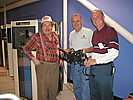
Ed Allen Glenn 729 Belts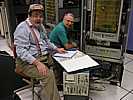
Ed Allen 729 Debug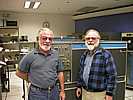
Dick Van Snyder
Bob Erickson ARC- Wednesday March 16th - 10 AM - Roll up sleeves -
Present were Ron Williams, Frank King, Bob Erickson, Allen Palmer, Ed Thelen, Don Cull, Robert Garner and Tim Coslet. (I think, I lost Ron's attendance list.) Ron changed the power arrangement from the Elgar to try to get it to supply the basic 1401 reliably. In retrospect he also changed the phasing. Since the 1402 phase sensor is by-passed, we did not notice that two phases got reversed which caused a lot of confusion as we tried to debug the 729 head retraction system. We got our hands slapped for trying to fix the Documation M600L reader without permission last Saturday (above). The reader is used to read 1401 decks for simulation.Computer History Museum staffers Kirsten Tashev (Vice President of Collections & Exhibitions) and Dag Spicer (Senior Curator) came down the the 1401 Restoration Room and stated that all future requests by the 1401 Team Volunteers for documentation/hardware should be written on the forms they provided. The Museum will try to make a response or request for clarification within a week.
Ron and Bob worked on the 077 collator and 1401. Without enough 50 Hz power to power all of 1401 memory, we cannot read any memory. - It was not a good day.
- March 20th - Robert Garner's Monthly Status Report
- March 21st - Dan McInnis's 1401 Card to Disk Progress Report
- Wednesday March 23rd - 10 AM - Roll up sleeves -
Present were Ron Williams, Bob Erickson, Allen Palmer, Ed Thelen and Robert Garner. Allen and Ed worked on 729 tape drive mechanicals - found some weather stripping at Orchard Supply Hardware that could be used to replace decomposed stripping in the drives.
Ron and Bob had a frustrating time trying to make memory work. We wanted a camera to show the rest of the world the drive voltage swings going into the switch cores the drive the memory planes. Fantastic, driving non-linear switch cores to drive non-linear memory cores ;-)) Wild!- Saturday March 26th - 10 AM - 4nd Saturday - Roll up sleeves -
Ron Williams and Bob Erickson were present - Ron pulled 2 bad SMS cards from the 1401 address logic. Bob worked on the 077 colator.- Tuesday March 29th - 10 AM - Special Session - Delivery of Pacific Power 50 Hz power source
Allen Palmer, Ron Williams and Ed Thelen were present. Mike Zahares had picked up the Pacific Power units from IBM, Cottle Road. The units were acquired as per winning bid to IBM opened Feb 22. IBM was a "little slow" in announcing the winner. Mike Z & crew arrived CHM about 11:25 and delivered the primary unit (18 KVA) to the 1401 Restoration Room and the slave unit to storage. Jim Yee started connecting power from another power pannel in the room, and checked with Ron about power connection at the 1402 (the central focus of power in the 1401 system).
Mike Z's crew also removed the cable crate and a multitude of sheet metal "skins" from the 1401 room to more protected storage - after a discusion in labeling technique of the "skins" involving staffers Kirsten Tashev, Allison Akbay and volunteer Allen Palmer.
After some confusion about the complicated programmable remote Pacific Power control unit and its cut cables, a simple control unit was discovered hidden at top of the large rack of the power unit. Removing a large aftermarket output voltage switch revealed a simple control panel where 3 phase 50 Hz power could be selected. :-))
With good luck, we will "soon" have adequate power to run the 1401 system. :-)))
Allen and Ron want a positive disconnect from the Pacific Power and the 1402 (1401 system power). There is a pair of relays the controls connectability of
- the 9 power amplifiers (grouped in 3s) into the 3 phase output transformer system
- an internal common to the neutral output wire
This is controled by the 3 phase selection. I am trying to find if this is also in series with some of the red "OUTPUT POWER OFF" buttons.- Wednesday March 30th - 10 AM - Roll up sleeves -
Present were Frank King, Ron Williams, Bob Erickson, Allen Palmer, Ed Thelen. It was determined that there would be a plug disconnect between the Pacific Power and the 1401 system. Jim Yee worked to connect the Pacific Power to the wall and install the plug disconnect. He did not complete - will be back Thursday afternoon to try to complete the installation. The volunteers did non-electrical work including schematic checks, a tidying up of cabinets, and area.- Thursday March 31th - 1:00 P.M. - Special Session -
Present were Jim Yee (volunteer/electrician), Ed Thelen. It was determined by others that there would *not* be a plug disconnect between the Pacific Power and the 1401 system. Jim Yee completed connecting the Pacific Power to the wall and to the 1402 (1401 system). - Saturday January 8th - 9:30 AM - second Saturday - free food ;-)) and work also

